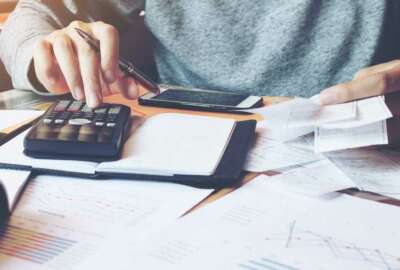
New role for agency CFOs starts with automation, shared services
The Treasury Department’s Bureau of Fiscal Service lays out ambitious goals to strengthen the central processes of disbursing, collections, reporting and...
Best listening experience is on Chrome, Firefox or Safari. Subscribe to Federal Drive’s daily audio interviews on Apple Podcasts or PodcastOne.
The Treasury Department issued a new 10-year vision for federal financial management focused on making improvements across four broad areas.
At the heart of many of those improvements will be technology changes and expanded offerings from the Bureau of Fiscal Service.
Kim McCoy, the commissioner of the Bureau of Fiscal Service in the Treasury Department, said more importantly, the 10-year vision will help transform the role of federal chief financial officers.
McCoy wrote in the annual letter to CFOs that the vision lays out “ambitious goals” that BFS hopes to achieve in the next few years to strengthen the central processes of disbursing, collections, reporting and administrative services. She asked the CFOs to review the goals and determine how they might translate a goal into action within their organization.

“What’s different about the letter this year is it speaks directly to agencies from their perspectives about where we can lend value in reducing their transaction processing load,” McCoy said in an exclusive interview with Federal News Radio. “An example of that might be reconciliations for intergovernmental transactions and using the G-Invoicing initiative. It could be greater automation of the way they disperse funds or the way they collect funds.”
Once it reaches full capabilities, the G-Invoicing program will be the front-end application for users to originate intergovernmental transactions and will manage the receipt and acceptance of general terms and conditions (GT&C) agreements and orders.
The new 10-year vision focuses on four core areas that the bureau will help CFOs:
- To optimize disbursing of funds — By reducing by 17 million down to 40 million the number of paper checks Treasury prints by 2020, and by increasing the percentage federal payments treasury disburses to 95 percent from 87 percent by 2021.
- To transform how they collect money — By streamlining the lock box system and replacing them with digital systems.
- To strengthen reporting — By making federal spending data more accessible through USASpending.gov and automating interagency transactions.
- To expand services — By providing additional analytics through the Do Not Pay portal and offering more services through the Administrative Resource Center.
McCoy said the Fiscal Service plans to provide specific services and initiatives under each of these broad areas to help CFOs transform the way their offices work.
Many CFO offices are stuck in the in the endless circle of processing transactions from vendors, from other agencies and for employees, according to a January 2018 Association of Government Accountants survey.
For many CFOs, the framework around their offices hasn’t changed much ever since President George H.W. Bush signed the CFO Act into law nearly 28 years ago. The law established the role of the CFO and created the framework for their offices.
CFOs can focus on performance
McCoy said the bureau recognized the trend around transaction processing and the vision is trying to help make change.
“In looking at the role of the CFO across the federal government, the CFO doesn’t have a lot of opportunity to focus on program performance when they are buried in transaction processes and they have to focus on maintenance of systems. It’s expensive and time consuming, “ McCoy said. “We believe by moving to centralized and shared services across the federal government, the CFO can have more time to focus on performance management and achieve that overall vision that the American citizen has in how they should receive services.”
McCoy said part of that move toward shared or centralized services is meeting the President’s Management Agenda’s cross-agency goal of moving employees to high-value work from low-value work.
“We also are doing that internally. While we are very interested in processing transactions to others, we want to do that as efficiently and as effectively as possible. We are looking at new technology like robotics and how we can automate our processes,” she said. “The G-Invoicing is a good example of our change in approach to working with federal agencies. We formed a federal financial management standards committee and vetted the approach to implementing the G-Invoicing solution government through that group of deputy CFOs. Based on their feedback, we were able to adjust the schedule, adjust the roll out pattern to be better aligned with what they needed to meet their mission.”
Treasury’s shared services
McCoy said G-Invoicing is considered a centralized services because it’s not reimbursable versus a shared service, like their E-Invoicing platform, which agencies do pay a fee to use.
A portion of the G-Invoicing platform is up and running, and subsequent capabilities are coming over the next 18-to-24 months before it reaches full operational capability.
McCoy said she believes the bureau can help the small and medium agencies the most with shared and centralized services.
BFS has been on the forefront of testing out many emerging technologies such as robotics and blockchain. In fact, the bureau’s Office of Financial Innovation and Transformation is working with the National Science Foundation and the Interior Department to bring robotics process automation to specific financial systems.
McCoy said the bureau will continue to bring innovation to the financial management community through the creation of an innovation program to work with other agencies to share good ideas.
“This gives us an opportunity to partner with agencies that we service to solve problems that we can take those solutions and spread them across the government,” she said. “We are working on a fraud, waste and abuse playbook. It’s a good example of where we are working with one agency and all agencies can take the benefit of that work.”
Copyright © 2025 Federal News Network. All rights reserved. This website is not intended for users located within the European Economic Area.
Jason Miller is executive editor of Federal News Network and directs news coverage on the people, policy and programs of the federal government.
Follow @jmillerWFED





